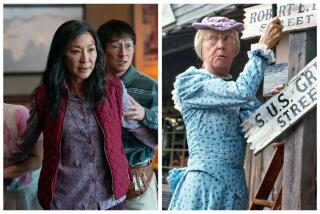Geraldine Hoff Doyle dies at 86; inspiration behind a famous wartime poster
Geraldine Hoff Doyle, a World War II factory worker whose bandana-wearing image in a wire-service photo is said to have been the model for the woman depicted in the 1942 “We Can Do It!” poster, has died. She was 86. The iconic wartime poster became an enduring symbol of women’s power from the Rosie the Riveter era.
Doyle died of age-related causes Sunday at Hospice House of Mid-Michigan in Lansing, said her daughter Stephanie Gregg.
Doyle was a 17-year-old high school graduate when she took a job at the American Broach & Machine Co. in her hometown of Ann Arbor, Mich., in 1942, a time when millions of women across the country were going to work to replace men who had gone to war.
“She had just graduated, and some of the young men had left school to volunteer to fight,” Gregg said. “A couple had been killed, and she felt she wanted to do something for the war effort.”
Doyle was operating a metal-stamping machine when a United Press photographer took a picture of the tall, slender and glamorously beautiful brunet wearing a polka-dot bandana over her hair.
Her photo, according to an account on the Pop History Dig website, was seen by Pittsburgh artist J. Howard Miller, who was commissioned by the Westinghouse War Production Coordinating Committee to create a series of morale-building posters to inspire Westinghouse factory workers.
Miller’s “We Can Do It!” poster portrays a woman in a red-and-white polka-dot bandana and a blue uniform, rolling up a sleeve over a flexed right bicep.
Gregg said her mother, who was not as muscular as the woman depicted in the poster, had no idea her photograph had been used as a model for Miller’s poster until the mid-1980s.
“She was tickled to recognize that she was the inspiration for so many women,” said her daughter.
Doyle, who was born July 31, 1924, in Inkster, Mich., actually worked in the factory only a couple of weeks; a cello player, she quit after learning that the woman she had replaced had injured her hand on the metal press, her daughter said.
She then got a job at a bookstore in Ann Arbor, where she soon met her future husband, Leo H. Doyle, who was in dental school. They were married in 1943 and had six children. Doyle also worked as the office manager at her husband’s dental office until she was 75.
The “We Can Do It!” poster image has been reproduced frequently in recent decades on a variety of items, including on a U.S. postage stamp issued in 1992.
“You’re not supposed to have too much pride, but I can’t help to have some in that poster,” Doyle told the Lansing State Journal in 2002 after she was invited to speak at the Michigan state Senate.
“It’s just sad I didn’t know it was me sooner,” Doyle said. “Maybe it’s a good thing. I couldn’t have handled all the excitement then.”
Doyle appeared at a number of poster signings and events at the Michigan Women’s Historical Center and Hall of Fame over the years.
“She was a very gracious woman,” said former executive director Gladys Beckwith.
The poster, Beckwith said, “represents Rosie the Riveter, a really strong woman who has taken on a non-traditional role and is happy in it and is contributing to the war effort. It’s a very significant image, one that has endured.”
Doyle’s husband of 66 years died in February. A son, Gary, died in 1980.
In addition to her daughter Stephanie, Doyle is survived by her other daughters, Jacqueline Drewes, Deidre Doyle and Lauretta Doyle; her son, Brian Doyle; her sister, Virginia Watson; her brother, Clifford Hoff; 18 grandchildren; and 25 great-grandchildren.
More to Read
The biggest entertainment stories
Get our big stories about Hollywood, film, television, music, arts, culture and more right in your inbox as soon as they publish.
You may occasionally receive promotional content from the Los Angeles Times.










